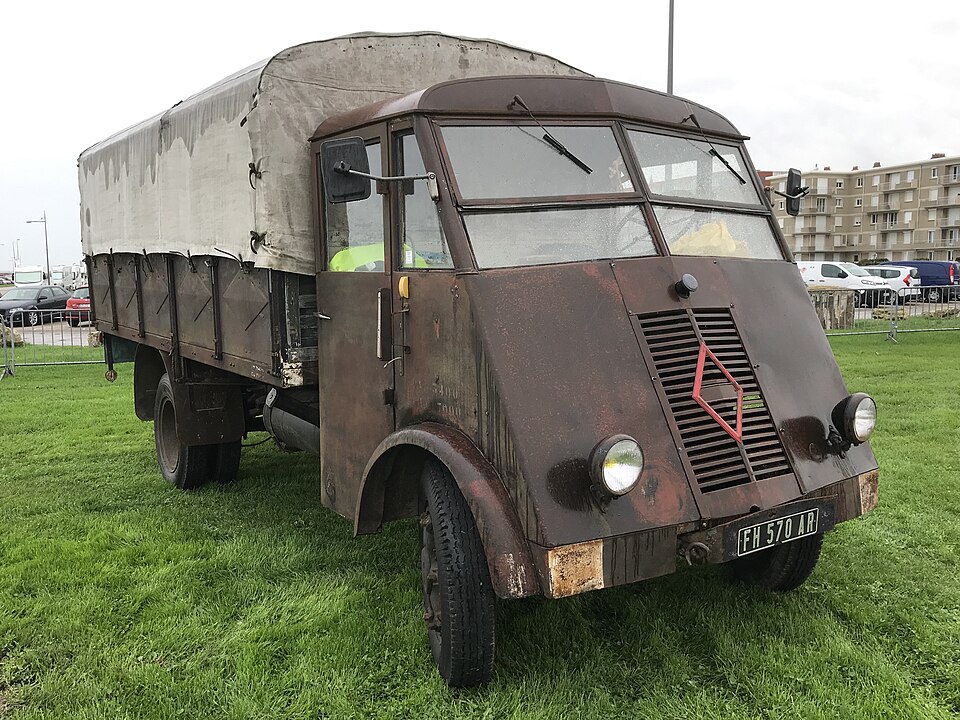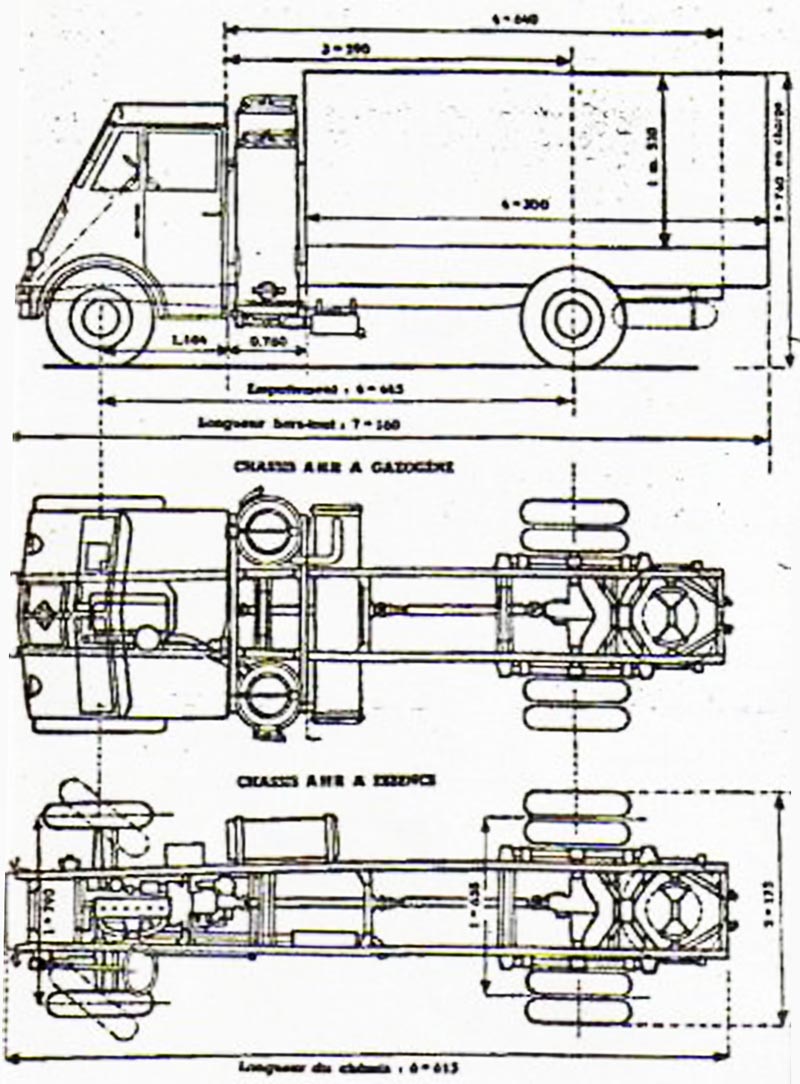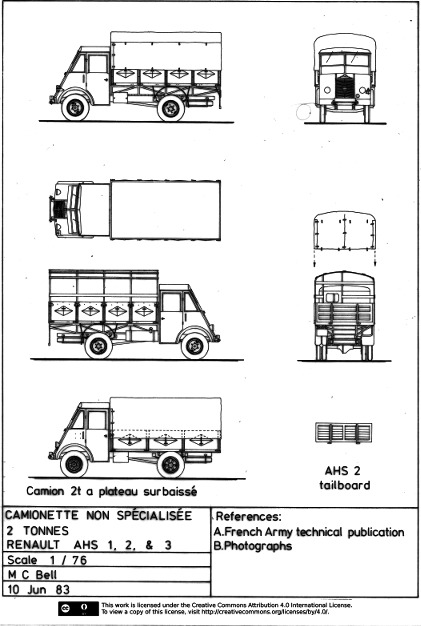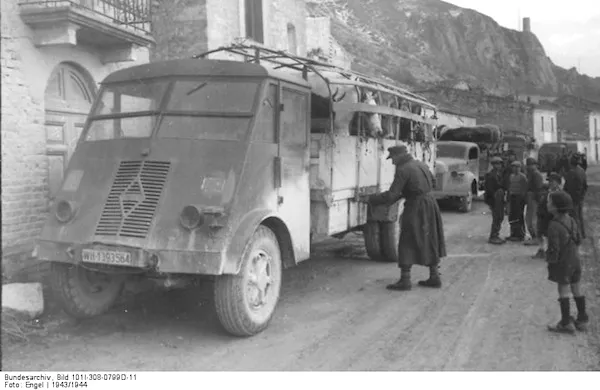Renault AH series

 Light/Medium 4x2 Truck, about c50,000 built 1941-47
Light/Medium 4x2 Truck, about c50,000 built 1941-47
Introduction

The Renault AHx was a series of light to medium-duty trucks produced by Renault between 1941 and 1947 under German supervision, assembled in Boulogne-Billancourt, France. Producton entirely went to the Wehrmacht, and a few to the Kriegsmarine and Luftwaffe. The Renault AHx series represents a fascinating intersection of wartime exigency and automotive evolution and was emblematic of industrial adaptation under occupation—continuing production under German command. The efficient cab-over design predated and influenced post-war commercial truck development. Many were repurposed for civilian use after the war, bridging the gap into modern Renault commercial vehicles.

AHS: Light-duty version, ~2 tonnes payload. Equipped with a 2.38 L inline-four engine (~52 PS). Gasifier versions (AHSH) offered ~35 PS
AHN: Medium-duty, around 3.5–4 tonne payload, using a 4.05 L inline-six (~75 bhp). Also available in gasifier form (AHNH) at ~52 PS
AHR: Heaviest model with ~5 tonnes payload, similarly equipped with the 4.05 L inline-six (~75 bhp) and also offered in gasifier form
Development
Renault introduced forward-control cab designs in the 1930s, which continued into the AHx series. These trucks were developed as simpler, more economical successors to the pre-war AGx/AGR range. The story of these vehicles can be summup as "born in freedom, built under occupation". In the mid-1930s, Renault received an order from the French army for the Renault AGR in 1937. This small 3.5-ton payload truck was appreciated by the army, which purchased several thousand. But in 1939 and the invasion of Poland, France went at war, prompting the army to order new vehicles. From June 1940 onwards, France was occupied and experienced difficult times. All the French industry was forcibly pressed to take part in the German war effort. At Renault, the Boulogne-Billancourt factory went under German supervision to continue production of utility vehicles, including the band new Renault AH series.
The Light One: Renault AHS

The Renault AHS prototype was presented in December 1939 (pinterest). It was developed to replace the Renault AGC for the French army. Its unladen weight was 2,480 kg and payload 2,500 kg but remained a single prototype, not selected for production. Series production started under the occupation from August 1941 and went on until March 1944. As the smallest in the series, it measured 5.60 m for 2.03 m in width, 2.41 m in height. It was only available as a cab version with a dropside platform, roll bars and tarpaulin, usable length 3.51 m by 1.86 m on the flatbed, dropsides 0.60 m high.
Its unladen weight was 2,400 kg with a payload of 2,000 kg. It was powered by the 1937 Renault Primaquatre 603 4-cylinder petrol engine of 2,383 cc rated for 46 hp at 2,800 rpm, coupled with a gearbox with 4 forward speeds and one reverse, 1:6.83 single reduction axle. Top laden speed was 60 km/h, fuel consumption 22 liters per 100 km. Total production was 7,985 units. No hooded cab but a cab-over with sloping flat face. This was the most produced of all three variants.

| Specs AHS |
| Dimensions : | 5,600 x 2,036 x 2,430 mm |
| Wheelbase and Tracks | 3,125 mm; 1,454 mm/1,520 mm |
| Weight: | 2,544 Kg empty, total 4,500 kg |
| Payload: | 2,000 kgs |
| Crew: | 1 drver +1 co-driver, 8 troops) |
| Propulsion: | Gasoline 4-cyl. 2,383 cm3, 46/47 hp/2,800 rpm |
| Speed: | 56/60 km/h |
| Range: | Fuel Consumption: 20 L/100 km |
| Production | 18 560 ex. +23 000 Wehrmacht |
The 5t variant: Renault AHR

The Renault AHR prototype was presented in December 1939, with an unladen weight of 3,940 kg and payload of 5,000 kg. It remained a single prototype, not selected for production. Series production started in April 1941, until March 1943. This later production version measured 5.60 m in length, 2.03 m in width, and 2.41 m in height. This cab-only version had a 60 cm dropside platform, roll bars and tarpaulin. Its unladen weight was 3,860 kg, payload 5,000 kg. It was powered by a Renault 4,086 cc 6-cyl. gasoline engine rated for 75 hp at 2,800 rpm, 4-speed forward, 1-reverse gearbox, single-reduction axle. Top speed was 60 km/h fuel consumption 30/35 liters per 100 km. Total production unknown (archives burned in July 1944).
It differed profoundly from its predecessor by having no hooded cab and instead a semi-forward cab with sloping flat front. It was produced on the same line as the AHN and AHS, but offered the highest payload. The cab ahd completely flat body panels common to the other two, the grille had simple horizontal bars, tere were buried in small round headlights, no bumpers, four sections windshield with upper sections opened by the driver and passenger in the summer for ventilation.

| Specs AHR |
| Dimensions: | 7,160 x 2,330 x 2,570 mm |
| Wheelbase and Tracks | 4,445 mm; 1,454 mm/1,520 mm |
| Weight: | 3,860 Kg empty, total 8,940 kg |
| Payload: | 5,000 kgs |
| Crew: | 1 driver +1 co-driver, 16 troops) |
| Propulsion: | Gasoline Renault 622B 4,086 cm3: 75 ch/2,800 tr/min |
| Speed: | 62 km/h |
| Range: | Fuel Consumption: 35 L/100 km |
| Production | 18 560 ex. +23 000 Wehrmacht |
The intermediate: Renault AHN

Renault held a prominent position with the AGR before it developed a new military vehicle, simpler to produce and inexpensive, to replace it. The first prototype was presented in February 1940 as the AHN, barebone and dumb simple with its flat surfaces, flat cab, no protruding hood, and sloping forward to the point it was called a "semi-forward cab" or "semi-COE". The payload was good at 4 tons, heavily inspired by AHR presented at the end of 1939.
The Renault AHR had for main difference had a longer wheelbase (4.44 meters instead of 3.73 meters for the AHN). The petrol version here reaches a top speed of 60 km/h, while for the gas-powered version the top speed is only 42 km/h. The equipment has been placed directly behind the cab, which reduces the loading length, and occupies 76 cm of the vehicle length. This leaves only 3.58 meters of the bodywork length, compared to 4.30 meters for the petrol version (4.30 versus 5.00 meters for the AHR).
It received Mines approval on February 14, 1941 and thus, production was monopolized by the Wehrmacht from March. The first sub-version was the Renault AHN1, but its payload was reduced to 3.5 tons. Its engine was a four-liter six-cylinder rated for 75 hp, enough for 59 km/h. It was also ordered by the Vichy regime to replace its elderly fleet requisitioned by the German army.
In May 1941, a gas-powered version was added to the AHN1 offering as the "AHNH1" (only 271 produced until December 1942) for the civilian market but without a gassifier, so it could not avoid the gasoline shortage, ending rapidly or converted. The first series AHN (AHN1) went until July 1944, with 15,610 vehicles, with their headlights embedded. Production remained low due to the bombings at Boulogne-Billancourt, and workers sabotage, notably by depositing sand in the engine casings. German denomination was Renault Lastkraftwagen 3.5 t AHN.

| Specs AHN |
| Dimensions: | 7,160 x 2,330 x 2,570 mm |
| Wheelbase and Tracks | 6,450 x 2,330 x 2,600 mm |
| Weight: | 2,290 Kg empty, total 5,790 kg |
| Payload: | 5,000 kgs |
| Crew: | 1 driver +1 co-driver, 16 troops) |
| Propulsion: | Gasoline Renault 6 cyl. 4,086 cm3 75 hp |
| Speed: | 59 km/h |
| Range: | Fuel Consumption: 30 L/100 km |
| Production | 26,492 ex. |
Models & Production
Wartime Production: Initially intended for the French military, the AHS prototypes appeared by 1939, replacing the AGC. After France's occupation, the Wehrmacht took charge of production and used these vehicles under designations:
AHS as Lastkraftwagen 2 to (2 tonnes)
AHN as Lastkraftwagen 3.5 to (3.5 tonnes)
AHR following suit for heavier payloads
Production Volume Estimates: Approximately 23,000 AHS, 4,000 AHN, and 1,000–2,000 AHR were produced and supplied to the Wehrmacht. Post-War Use: After WWII, updated versions (AHS3/4 and AHN2/3) were produced for civilian markets. In 1947, the AHx series was replaced by the Renault Galion. Additionally, the AHx cab design influenced the later Renault 208 E1, a 7-tonne payload truck.
The AHN led to sub-variants such as the Renault AHS-1 (Feb. 1942 - July 1944) gas-powered with the same engine but gas generator type 703 reducing power to 35 hp at 2,800 rpm, payload 2,000 kg. The rear axle ratio was 5x43 for a top speed of 51 km/h unladen, 48 km/h laden, and a limited production of 347 vehicles.
The other sub-variant was Renault ASH-2 (Sept. 1944 - Sept. 1945) same as the ASH 1 but woth a full gas generator, power output 35 hp, with new headlights and steel wheels replaced by artillery-style wheels (common on the AHN). Production was limited to 275.
The Renault AHS-3 (Nov. 1944 - June 1946) was an "Updated" liberation version of the ASH 1 Produced to 6,253 units. It was replaced by the Renault AHS-4 (March 1946 - February 1947) postwar, with a lowered platform requiring modified wheel arches. Production: 3,700 units. For the basic model, the Germans registered it as the Renault Lastkraftwagen 2t (1941-1944) with a pproximately 23,000 all AHS types combined.

For the AHR, the largest, the majority was intended for the German army, with exact numbers estimated around 1,445 vehicles produced, plus 2,000 for the German army between 1941 and 1944 based on plate numbers. After the liberation, production stopped in accordance with the requirements of the Pons Plan, with assigned Renault the manufacture of 3.5-ton trucks only. There was a Gas-powered version with a power output of 52 hp at 2,800 rpm and top speed of 40.9 km/h (25.4 mph) unladen. Production owas just of 142 vehicles used by the civlian sector in France. Surviving ones were converted back in 1945. The other sub-variant was the Renault AHZ (from March 1941), a 6x2 variant adding a second axle on the extended chassis of an AHR for a payload 6,000 kg. Single prototype, which was used inside the factory for internal transport of parts.
For the AHN, the first series was of 15,610 vehicles from February 1941 to July 1944, before bombings stopped it. It was resumed by November 1944 after the liberation of the Billancourt plant by the Allies. Renault then launched the AHN2, reserved for the French war effort, and then surplus were sold on the civilian market. Modifications were minimal and there was a total until June 1946 of 8,400 units, plus in parallel the gas-powered version AHNH2, produced between October 1944 and May 1945 with 211 units. From June 1946 appeared its ultimate evolution, the AHN3 with a dropside platform lowered by 22 cm, length reduced by 12 cm, width increased by 12 cm, manufactured until January 1947, with c2,000 for the civilian market. It was replaced by the Galion.
The Lastkraftwagen AHx in service

As we saw earlier, production of the Renault AH was almost entirely focused on the needs of the Wehrmacht, including a few used by the Lufwaffe and by the Kriegsmarine for specific needs. The simplicity of the vehicle interested German autorities, that saw its potential for arge productions in order to replace lost vehicles, but its limitations were also well understood. They were supposed to have been military vehicles, but were not designed for off-road use and only integrated tooling and stowage bins. They had no winch and stuck to good roads for their service, used in France and throughout occupied western and easter Europe, but rarely in Russia given its limitations.